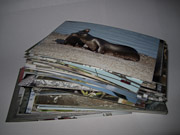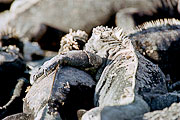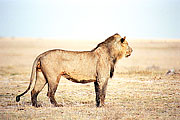
|
Many photographers take thousands of photos. Obviously you want to keep them. But are your photo’s really safe? |
This article describes my way of storing my photo’s safely. I use these storage, archival and back-up measures for all of my important data. Currently I have almost 2 Terabyte of important data (!!!).
Why?
A good photo storage method should cater for a number of unfortunate events:
- Disasters (like theft and fire)
- Stupidity (for example overwriting an important file)
- Malfunctions (problems with your hard disk)
Furthermore, storage should be:
- SAFE
- AVAILABLE
- FAST
What?
My data is stored on several media:
- NAS (Network Attached Storage): data that I want to access anywhere, anytime, from anyplace (accessible over the internet). My NAS is configured in RAID-1 configuration. This means, if one of the hard disks dies, all data is still stored safely on the other hard disk. Drawback of the NAS is that it is relatively slow (roughly 40 MB/s over gigabit Ethernet);
- Internal hard disks: I have two 1TB hard disks in RAID-0 (striped) configuration. This gives me about 250 MB/s read speeds. The drawback is that if one hard disk malfunctions, I could loose all data on both disks.
In short, my most important data is on the NAS (safe and accessible). This includes all RAW photo files.
All other files, including all photo’s currently being edited or finished editing are stored on the internal hard disks. Advantage is that this data is retrieved very fast. My 24.6 MPix camera (see equipment) gives me huge files. An image edited in Photoshop in 16bits with a few layers gives files of up-to 500MB per image. Some stitched panorama’s a multiple of that. To edit these files comfortably, I need the speed of the RAID-0 disks as it takes “only” 2 seconds to load a 500MB image, instead of 12 seconds if I would use the NAS. Note that 2 seconds response time is considered “acceptable fast” when working with a computer. I have considered buying SSD’s instead but I would rather invest the fortune it requires to buy 2TB SSDs in new lenses.
But wait, I said that my files should be stored SAFE. Raid-0 isn’t safe, is it? Please read on :-).
Back-up and back-up tools
I have one external hard disk connected to my computer and regularly copy changes on the local disk and on the NAS to that external hard disk. If something happens, I can easily retrieve data from that hard disk. So, if one hard disk would die, I would only loose the work I between now and the last time I created the copy.
Roughly once per half year, I take the external hard disk and store it in a small safe that I rent from the local bank. That safe costs me less than 100 Euro per year and stores next to the hard disk some other valuables.
I’m lucky that I have the possibility to rent a safe. Strange but true: renting a safe in The Netherlands is not very easy as banks tend to close them. Probably they are not earning enough money (…). Alternatively, you could ask a friend or a relative to store a hard disk for you, or even leave the hard disk at the office of your day-job.
In the past, I used Microsoft SyncToy to copy my data to an external hard disk. I used the an “Echo” folder pair and it worked perfectly. Only drawback of SyncToy is that it sometimes take a long time to determine what data has to be copied. The reason is that I have over 100.000 files on my company-laptop and SyncToy does not seem to handle large number of files well. In the end, I created my own Sync tool, which does the trick in a fraction of the time that SyncToy needs :-). For average work, however, SyncToy should perform the job just fine and I recommend the tool. Best of all: it is free!
Media
In the past I have considered backing-up my data on DVD media (or blue-ray). For all my data, I would need 400 DVDs of 50 blue-ray discs. That is not very practical to burn them one at a time unless you are very patient (unlike me). Please be advised that DVD media are not very reliable as well. They wear out relatively fast.
Similarly, also do not expect hard disk to survive much longer than 10 years. You can now buy an external hard disk for well under 100 Euro’s. I consider that a relatively low insurance cost, so by all means buy yourself a new one, once in a while. Or deep-format an old hard disk and rewrite your back-up data to that hard disk to make sure that you get no write errors.
Other considerations.
Something you might need to consider is compatibility. For example, can we know for sure that all RAW images you took are supported by imaging software indefinitely? I recommend to store at least a high-quality JPG (or preferably a lossless TIFF file) of each RAW file. I guess that JPG and TIFF are here to stay, in contrary to current wide variety of RAW formats. Another suggestion is to convert the RAW file to DNG which is more like a standard format.
Conclusions & recommendations.
Here’s a quick resume:
- Store data in at least three places, of which at least one on another physical location.
- Think about compatibility and media wear-out.









